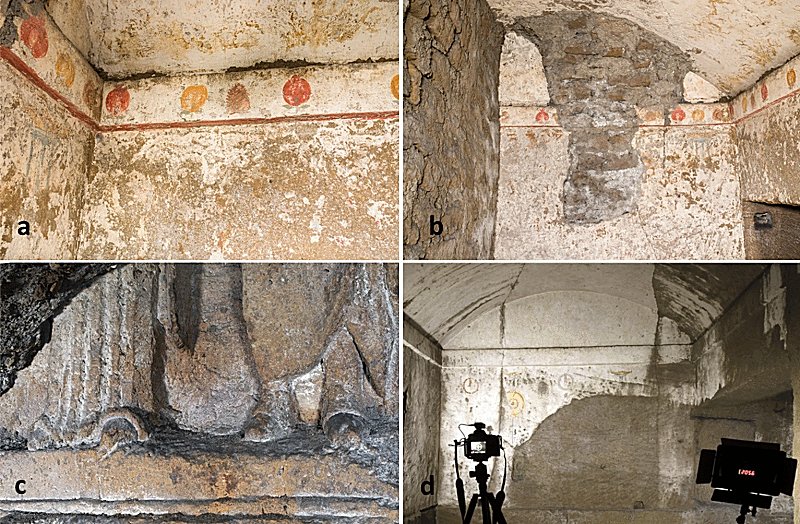Conny Waters – AncientPages.com – The underground of the city of Naples has no doubt many undiscovered secrets. The remains of the ancient necropolis of Neapolis- located about 10 m below the current street level at the Health District – represent one of them.
The Greeks built it between the end of the fourth and the beginning of the third century BC.

(a) Fragments of Greek burial chambers and (b) Ipogeo dei Melograni decorated with fruits frescoes along the walls (c) Togati – fragment of a high relief with a funeral farewell scene (d) chamber 8 in Fig. 11 with remains of frescoes on the North wall described by Neapolitan archaeologist Michele Ruggiero in 1888.
“Remains of the ancient Neapolis with its buildings, streets, aqueducts, and necropolis made by the Greeks starting from the second half of the first millennium BC are interred approximately ten meters below the current street level of the city of Naples,” write researchers in their paper.
The tombs – a part of the ancient necropolis developed in this area in the VI–III century BC – are decorated with beautiful frescoes and sculptures in high relief. The cemetery was created by wealthy Hellenistic families.
Successful diggings archaeological research led to the discovery of the Hypogea of Togati and Pomegranates. Thus, researchers could begin speculating on additional unknown monuments at the site. Unfortunately, the exceptionally high population density and accessibility of this particular area make it very difficult to proceed with systematic excavations.
Therefore, the team from the University of Naples Federico II and the National Insтιтute of Nuclear Physics (INFN) used muon radiography in collaboration with the University of Nagoya, Japan. Due to its non-invasive nature, it is particularly suitable in urban environments where it is not conceivable to apply active survey methods such as drilling or seismic waves.
This technique uses muons, particles produced in the cascade that follows the interaction of cosmic rays with the Earth’s atmosphere, to reconstruct an image of the internal structure of an object. According to researchers, the principle is similar to that of X-rays, with the advantage of being able to investigate objects much larger and distant from the point of observation, due to the greater penetration capacity of muons compared to rays X.
Several detectors capable of detecting muons – high energy charged particles produced by cosmic rays in the upper layers of atmosphere – were installed underground at the depth of 18 m, to measure the muon flux over several weeks. The instruments collected data for about a month, capturing about 10 million muons, thanks to which it was possible to reconstruct a stereoscopic view of the overlying layers, defining the three-dimensional position of a new burial chamber.
Researchers have clearly observed the known structures as well as a few unknown ones. One of the observed new structures is compatible with the existence of a hidden, currently inaccessible, burial chamber.
The ancient area of the necropolis have changed much, and a fast-growing urbanization has been developing since the XVI century. The new constructions, while intersecting the ancient monuments, have often incorporated or partially destroyed them.
Despite the profound transformations of this area over time, recent studies allowed to figure out the original morphology of the ancient necropolis landscape with burial chambers, developed along the road originating from the North Gate of Neapolis.
Paper
Written by Conny Waters – AncientPages.com Staff Writer





